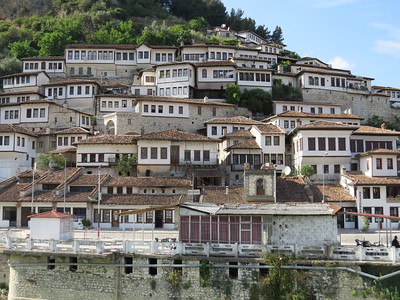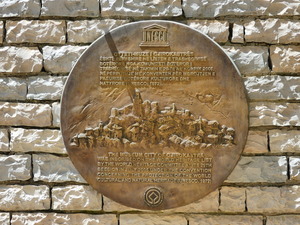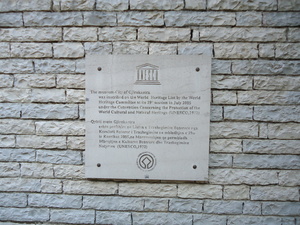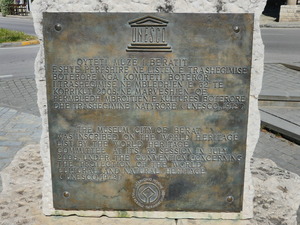Berat and Gjirokastra

The Historic Centres of Berat and Gjirokastra are well-preserved Ottoman towns, decorated with outstanding examples of kule: Balkan-Ottoman style tower houses.
Berat has been particularly marked by the peaceful coexistence of Ottoman Islam with a large Christian minority. The designated area includes Berat Castle, mosques, churches, and the Gorica Bridge. Gjirokastra was built around a 13th-century citadel and developed into a regional center. Residential quarters, the bazaar, churches, and mosques were built vertically and in stone.
Community Perspective: the two towns lie some 150km apart, complement each other and they warrant an overnight stay each.
Map of Berat and Gjirokastra
Community Reviews
Kokoro
I visited both cities in May 2023 and will not add anything regarding architecture and history - since there are many very qualified reviews. However I would like to give an actual update of situation and how to get there.
BERAT
How to get there:
Berat is very easily accessible by car or bus, just 1 hour drive from Alabania´s capital Tirana.
Sightseeing situation:
Heavily visited and crowded, but also easy to visit (but not wheelchair accessible since streets are very steep).
GIROKASTER
How to get there:
Girokaster also is well accessible by car and bus from Tirana (200 km or 3,5 hours - due to newly built highway)
Sightseeing situation:
Heavily visited and crowded (lots of package tourists), not wheelchair accessible since streets are very steep.
Clyde

I visited Berat and Gjirokastra in Spring 2022 staying a couple of nights in each. At the time of my visit both towns road infrastructures were undergoing major renovations which should be addressing the major problems related to sanitation and electricity systems of both towns in the near future. Apart from the dusty welcome, both towns were truly the highlight WHS in Albania and both complemented each other and were worthwhile visits.
Especially Berat is perhaps a bit comparable with Safranbolu, Turkey and Ohrid, North Macedonia with an excellent setting surrounded by mountains and hills, including the Tomorr national park on the east, and the river Osum. The 15th century historic centre of Berat can be divided in three: the Castle (Kala) quarter, the Mangalem quarter (with the Islamic centre known as "the City of a 1,000 windows") and the Gorica quarter. The latter lies opposite the Mangalem quarter and is reachable through the "modern" pedestrian bridge or the old seven-arched Gorica Bridge. Rather than for the Ottoman qualities of this WHS, the highlights of this quarter are the 19th century Church of Saint Spiridon and the 19th century Church of Saint Thomas and the remains of the fortifications of Gorica.
The Mangalem quarter is the heart of Berat with its very narrow streets and its four highlights are the former palace of the Pasha, the 14th century Church of Saint Michael, the Islamic Center and above all the 19th century Bachelors Mosque with its exterior and interior frecoes, a bit similar to the old mosque in Skanderbeg Square, Tirana. As a stopover along the strenuous uphill hike up to the Castle quarter, I enjoyed taking in the vernacular dwelling houses which are quite similar to the ones in Gjirokastra (although not as beautiful). The fortified citadel walls enclose several monuments and remains. The highlights here were the excellent views over the Gorica and Mangalem quarters below, the Onufri Museum in the Cathedral of the Assumption of St Mary, the Red Mosque (minaret), and the excellent mountain views from the Church of the Holy Trinity. The setting of the Kala quarter reminded me a bit of the setting at the Mystras WHS in Greece. There is a UNESCO WHS plaque just opposite the Bachelors Mosque.
The Gjirokastra WHS component offers a unique pattern of Ottoman architecture and panoramic views of the dramatic Drino valley and the still snow-capped peaks of Mt Lunxheri. Overall, Gjirokastra seems to have suffered much more from a recent urban sprawl with modern buildings than Berat, so the historic centre is more of a patchwork of top-notch vernacular houses and important traces here and there of Ottoman architecture. The castle visit wasn't as fulfilling (in terms of the WHS' OUV) as that of Berat although the artillery collection was really impressive. The Old Bazaar quarter seems to be the most intact with its unique limestone masonry. The definite highlight of Gjirokastra for me were the impressive visits of the Skenduli House and the Zekate House. They truly are an outstanding example of the local architecture of the city, with authentic elements inside and out such as the beautiful Skeduli house chimney and the top floor rooms of the Zekate House.
If you have more time on your hand, a visit to the Mecite quarter and hammam can be rewarding too although rougher than the other quarters with glass lizards, stray dogs, litter and some shady areas while looking for the Hadji Murat ruined mosque and the 7 fountains scattered around this historic quarter. A bit like Safranbolu, Turkey too, nearby Gjirokastra lies the worthwhile Ali Pasha bridge/aqueduct. The UNESCO WHS plaque of Gjirokastra can be found at the start of the main street just after the Greek consulate.
Nan

Arriving at Gjirokaster, I wasn’t sure what to expect. At first glance, there were no notable structures. Gjirokaster seemed to consist exclusively of the usual communist concrete fare. So was this it? Luckily not.
Historically, the valley of the Drino River was reserved for agriculture. The locals built their towns and villages on the slopes of the surrounding hills and mountains. And up in the hills, you will find in Gjirokaster: a great example of Ottoman architecture in the Balkans. Frankly, during my travels, I have seen nothing comparable in the Balkans.
As recommended by Els I visited the Zekate house. I also went to the castle. But mostly I enjoyed strolling through the cobblestone streets and taking pictures of the Ottoman houses covering the hillsides.
To me, this is a unique site that embodies the Ottomans and the Balkans. It’s also a great representative for Albania and their culture. I think it’s well worth a visit. Be prepared, though, for an almost obsessive-compulsive level of guest friendliness.
Getting There
The easiest access point for southern Albania including Gjirokastra is Corfu. There are plenty of connections from Europe to the Greek island. From Corfu several daily ferries can take you to Saranda in Albania. You will even gain 20min as the ferry takes 40min and Greece is one hour ahead of Albania. From Saranda, you can take a minibus. These depart in front of the synagogue ruins on Rruga Flamurit. The bus stop is Gjirokaster is down in the valley.
While You Are There
Visiting both Corfu and Butrint is possible from Saranda.
On your way to Gjirokaster, you can also visit the Blue Eye. It’s promoted heavily to tourists and part of the standard itinerary of a day trip of cruise ship guests. But I found it underwhelming, especially as there are no hiking trails into the hills. If you want to visit nonetheless, ask the driver to let you off at the entry. From there it’s 20min walk to the site. To continue to your destination, return to the road and signal the minibus (they pass hourly).
The tradition of agriculture has continued to this day. Nearby Lazarat is a leading supplier for weed in Europe. I would discourage visiting.
Els Slots

Berat and Gjirokastra are two towns in Central Albania, located some 150 km apart. Their strength lies in vernacular urban housing and monuments from the Classical Ottoman period. Both are also towns that developed in and around a citadel. Gjirokastra is locally called Gjirokaster, the -kastra comes from the Northern Albanian dialect. It first became a WHS on its own in 2005, while Berat was added as an extension 3 years later.
I started my visit to this WHS in Gjirokaster, en route from Butrint to Tirana. I arrived by bus in the Lower Town and decided to walk up to the historical area. It does look like a steep climb, but it takes only 20 minutes and it awards one with great views of the rows of tower houses Gjirokaster is known for. The historic center has a real authentic feel and I had a great time staying there overnight. This was further enhanced by local son Ismail Kadare's Chronicle in Stone, which I was reading. He describes life as a child in Gjirokaster during World War II. At that time it was a city with so many mosques "you could walk down the street, stretch your arm, and hang your hat on a minaret".
A few among Gjirokaster’s 200 tower houses are open to visitors. The Ethnographic Museum has interesting displays on how people lived, though the building itself is a modern reconstruction (on the site of the birth house of the other famous native, Enver Hoxha). Across the street lies the Skenduli house, which was returned to the Skenduli family after the fall of communism. They take visitors on a guided tour around their house, which is huge. The talks were informative, but the visit was a bit rushed. The best of the tower houses is Zekate house. This lies at the top end of the village, a house that had attracted my view already from various viewpoints around town. Here one can wander alone from room to room, and for example admire the painted fireplace.
In the late afternoon, I climbed once more, this time to the Castle of Gjirokaster. It houses a military museum (which is not exactly to my taste), but it holds some other points of interest such as a tekke from the Bektashism sect and the remains of a US airplane captured during the Cold War. The on-site museum tells Gjirokaster’s history well and is very critical of Hoxha who they claim only visited his hometown a couple of times after he came to power, and only did so during staged mass rallies.
After Gjirokaster I travelled on by bus to Berat. Including a change in Fier this takes about 3 hours. Berat is a totally different city, much more ‘tainted’ by communist-era structures. The views on the old Ottoman quarters Mangalem and Gorica from both sides of the Osum river are worth it though. What it does have preserved better than Gjirokaster is its religious buildings. I especially enjoyed the small area with the King's Mosque, the Helveti Tekke and the Han (Inn) of the Derwishes.
A definite letdown for me was the Berat Citadel. It’s not in a good state (think: rubble, lots of trash, overgrown areas), and the structures need a great imagination to fit names such as 'Red Mosque'. Not to be missed inside the citadel however is the Onufri Museum – a museum holding icons made by the artist Onufri. It is located in the Saint Mary Church, which has its original wood-carved iconostasis from 1806.
Visiting Berat and Gjirokaster takes the best part of two days, and to me, these were the most rewarding and most 'Albanian' sights of my week-long stay in the country.
Bojana Bartol
Berat: The fortress area is spacious, but very good to roam on foot. The view from above is very nice, there were only a few other visitors there, so you could really look at everything in peace. The small museum is also worth seeing, but it costs extra. There are offered for sale very beautiful even embroidered tablecloths.
Gjirokastra: I highly recommend a visit. In my opinion it is the most beautiful city in Albania. Marvel at the old streets, houses covered with stone. This medieval atmosphere... You can visit the castle, which houses a military museum and a few old houses. You can stay overnight in one of the inns, to feel the atmosphere of Albania.
John booth

I recently travelled through Albania by bus from Ulcinj (Montenegro) to Sarande stopping in Skodra, Tirane, Berat and Gjirokastra along the way.
The road to Berat from Lushinje was the bumpiest of the journey, about 30 kms. The old town of Berat had much to offer in the way of churches, mosques and a monastery, as well as the castled perched above a cliff overlooking the whole region.
Similarly the view from the citadel of Gjirokastra extended over the whole Drina valley. The museum in the citadel contains quite an arsenal of old weapons, together with a captured US spy plane from the Cold War era.
Arber
I was in Gjirokastra just one day before it was proclaimed a world heritage site.My first impressions on the city were very complex, but one thought stayed in my mind during the whole trip, what was it like to live there 200 years ago, who were the people that lived in those magical and mystical houses, and what did the great castle witness during centuries of war. The city spoke of greatness and the stone houses together with the amazing view of the mountains and valleys, reflected the character of the people there. Amazing,rigid, mystical,friendly, this was Gjirokastra in one day for me.
Community Rating
- : Dutchnick Pasha Globus Vernon Prieto Tamara Ratz Giulio25 Sebasfhb Rahelka StaziG Klara Woodson Roccobot Rafał Kałczuga
- : Jxrocky Rvieira Pincze Szucs Tamas Maciej Gil Tarquinio_Superbo
- : Paolosan82 Hanming Weecheng Bag-packer-family Harry Mitsidis KeithBailey Kokoro CugelVance Cluckily ChrisDorn Kevin247 Riccardo Quaranta Chenboada Philipp Peterer Nan PabloNorte Alexander Lehmann João Aender Little Lauren Travels Stanislaw Warwas Kasper Dorejd
- : Merveil Tony H. Juropa Argo Frederik Dawson MoPython Zach Randi Thomsen Peter Lööv Walter Els Slots Clyde WestcountryWanderer Cezar Grozavu David Marton Roman Raab Daniel Gabi David Berlanda Jezza GerhardM Philipp Leu Ivan Rucek Alexander Barabanov George Gdanski Jarek Pokrzywnicki
- : Mikko Alexander Parsons Juha Sjoeblom WalGra Astraftis Can SARICA Jon Opol Martina Rúčková Svein Elias Lucio Gorla
- : Solivagant JobStopar
- : Zoë Sheng Yevhen Ivanovych Adrian Turtschi
Site Info
- Full Name
- Historic Centres of Berat and Gjirokastra
- Unesco ID
- 569
- Country
- Albania
- Inscribed
- 2005
- Type
- Cultural
- Criteria
-
3 4
- Categories
- Urban landscape - Urban continuity
- Link
- By ID
Site History
2008 Extended
To include the city centre of Berat
2005 Inscribed
1991 Referred
Bureau - mission to help Albania with Management plans etc
Site Links
Unesco Website
Official Website
Related
In the News
Locations
The site has 2 locations
Berat and Gjirokaster are well-served by public buses, whether you're coming from the North (Tirana) or South (Sarande/Butrint). Both are fairly sizeable cities on an Albanian scale. There are two direct buses a day between the two, or you can change for a more frequent connection via Fier.
Connections
The site has 35 connections
Art and Architecture
Constructions
Damaged
History
Human Activity
Religion and Belief
Science and Technology
Timeline
Trivia
WHS on Other Lists
World Heritage Process
Visitors
259 Community Members have visited.
The Plaque
 (photo by Clyde)
(photo by Clyde) (photo by Jarek)
(photo by Jarek) (photo by Clyde)
(photo by Clyde)